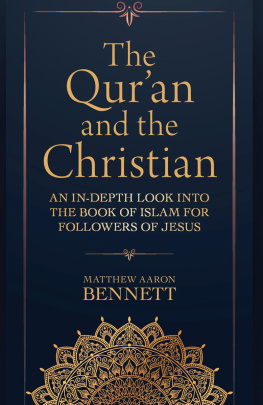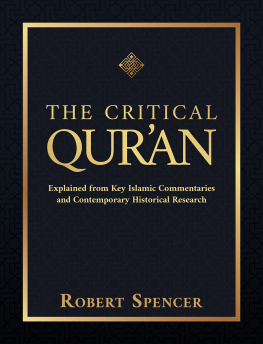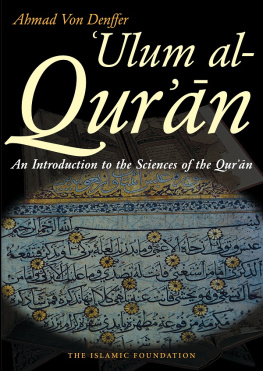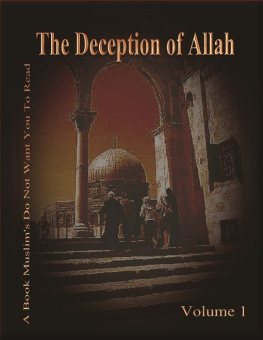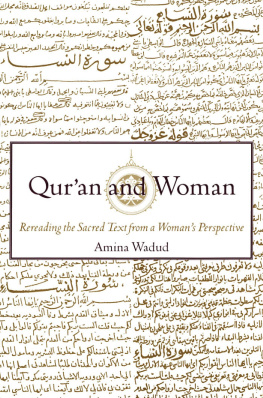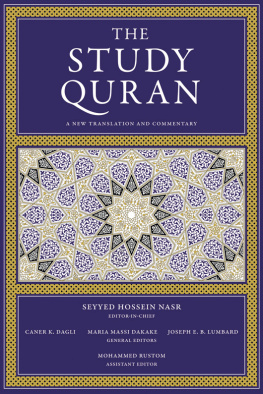The Bible and the Quran
The Bible and the Quran
Biblical Figures in the Islamic Tradition
John Kaltner and Younus Y. Mirza
Bloomsbury T&T Clark
An imprint of Bloomsbury Publishing Plc

Contents
During the 2016 spring semester, I taught a course titled Biblical Figures in the Quran that gave me the opportunity to reflect on pedagogical issues related to the content and design of this book. I thank the students in that course for their efforts, enthusiasm, and many helpful comments and ideas as we worked through the material together. Among those taking that course was Katie White, who was my student research assistant at the time, and I appreciate very much the many discussions she and I had about the course and this book. Debra Bartelli continues to support and inspire me in everything she does, and I dedicate this book to her with love.
John Kaltner
I want to thank my parents, M. Yaqub Mirza and Tanveer Mirza, for supporting my educational and academic endeavors. My dad always encouraged me to focus on my education and helped support my studies in the Middle East and during graduate education. My mom has been a constant inspiration and source of spiritual support; she consistently reminds me to keep in mind the bigger picture and to look at the long-term prospects. My wife Rehenuma Asmi has been a wonderful companion. I could not have finished this book without her encouragement and friendship.
Younus Y. Mirza
Non-Muslims are often surprised to learn that many people who are mentioned in the Bible play important roles within Islam. In fact, some of the figures from the past who are revered most by Muslims are also held in high regard by Jews and Christians because of their prominence in biblical literature. Muslims agree with their fellow monotheists about the importance of these individuals because of their understanding of revelation. Islam teaches that throughout history, prophets have been sent to deliver a message from God to their people, and many of those messengerslike Abraham, Moses, and Jesusare referred to in the Bible. Consequently, the lives of these prophets are held up as models to be valued and respected because they have provided guidance and insight about Gods will for humanity.
This book offers an overview of how biblical figures are presented in two key Islamic sources that are familiar to all Muslims. The first is the Quran, the sacred text of Islam, and the other is a set of writings known as The Stories of the Prophets. These sources not only examine the lives of well-known prophets like those cited above, but they also sometimes refer to less prominent individuals who are found in the Bible. When we refer to the Bible, we are speaking about the books that comprise the Hebrew Bible, the Old Testament and the New Testament. The nearly fifty entries in this book discuss people who are mentioned in both biblical literature and Islamic sources. Most entries look at a single person, but in a few caseslike angels, Jews, and Christianslarger groups are considered. Each entry examines key passages from the Quran that treat the individual or group, and many of them include some discussion of how they are presented in The Stories of the Prophets. In some cases, The Stories of the Prophets literature has nothing or very little to say about a person or group, and so those entries describe only how they are presented in the Quran. Each entry concludes with some questions for discussion and suggestions for further reading. Throughout the book, peoples names are written both in English and in a transliteration of their Arabic forms. The English translations of Quran passages are our own, and the citations from The Stories of the Prophets come from the works mentioned below. The remainder of this introduction provides some background information on the Quran and The Stories of the Prophets.
The Quran
The sacred text of Islam is closely tied to the life of the Prophet Muhammad (570632 CE ), who was from the western part of the Arabian Peninsula in what is now Saudi Arabia. According to the traditional account of his life, around the year 610 CE Muhammad had the first of a series of revelations from God that continued intermittently throughout the rest of his life. Islam teaches that the Quran is an accurate record of the messages that Muhammad received from God through the angel Gabriel during that twenty-two-year period. The word Quran (also spelled Koran) comes from the first word directed to Muhammadiqra, an Arabic command that means Recite! The term Quran means recitation, which underscores the books nature as an oral text that is meant to be proclaimed and heard aloud. The Quran is the oldest literary text in the Arabic language.
A central theme throughout the Quran is the need to follow and obey the will of the one God. This idea is so important that it was used to designate the religion that emerged from the Quran and those who follow itthe Arabic word islam means submission, and a muslim is one who submits. The call to monotheism was not well received by many in Muhammads earliest audience because they were predominantly polytheists, and so he and his early followers were sometimes persecuted by those who did not accept his message. They eventually left the city of Mecca, Muhammads birthplace, for a town some two hundred miles to the north that had invited Muhammad to serve as a judge who would help resolve disputes among its inhabitants. That town, which later became known as Medina, was more open to Muhammads message, and it was there that the Muslim community began to develop and flourish. The migration from Mecca to Medina in 622 CE , known as the Hijrah in Arabic, was such an important event that it marked the beginning of the Islamic calendar.
The Quran is comprised of 114 chapters of varying lengths that contain a total of approximately 6,300 verses, which is about the same number of verses found in the New Testament. In this book those chapters are identified by numbers, but each one also has a title that is a word, name, or theme found in the chapter. For example, , 65, and 101 also go by the names The Cow, Women, The Table, Abraham, Mary, The Spider, Divorce, and The Disaster, respectively.
The chapters of the Quran are not arranged chronologically but by length, with the longest ones coming first. The Quran begins with a brief introductory chapter called The Opening, and this is followed by the longest chapter in the book, which has 286 verses. Chapter 108 is the shortest chapter, with only three verses. The lack of a chronological arrangement can be seen in the fact that the command iqra mentioned earlier, which tradition says is the first word revealed to Muhammad, begins chapter 96. An important distinction is made between the chapters that were revealed in Mecca during the early part of Muhammads prophetic career, and those from the later time when he was in Medina. In general, those from the Medinan period tend to be longer, while the Meccan ones are shorter. This means that if one wants to get a general sense of how the Quran developed over time, it would be best to start with the shorter chapters and read the text backward. The decreasing length of the chapters throughout the Quran can be seen in a recent English translation of the text in which the first 57 chapters comprise 375 pages, while chapters 58 through 114 take up only 85 pages.
Muslims believe that the original Arabic form of the Quran is the only true version of it and that a translation is not actually the Quran but simply an interpretation. One reason for this is that the Arabic text is written in rhyming prose in which the last word of each verse in virtually every chapter ends in the same or a similar sound. Such a consistent rhyming pattern is impossible to duplicate in another language, and Muslims consider it to be an essential aspect of the text. Even those who do not know the Arabic language are struck by the beauty of the Quran when they hear it proclaimed by someone trained in the art of Quranic recitation. Since less than 20 percent of Muslims worldwide speak Arabic as their first language, most are not able to understand the Quran in its original form. In those places where Arabic is not spoken, when the Quran is read aloud, in mosques and other public settings, it is first proclaimed in Arabic and then translated into the local language. This explains why there are so many bilingual versions of the text that contain Arabic in one column and a translation in the other.


